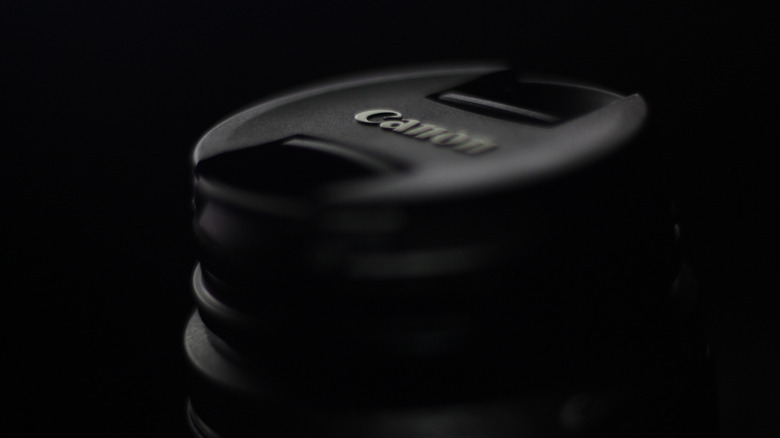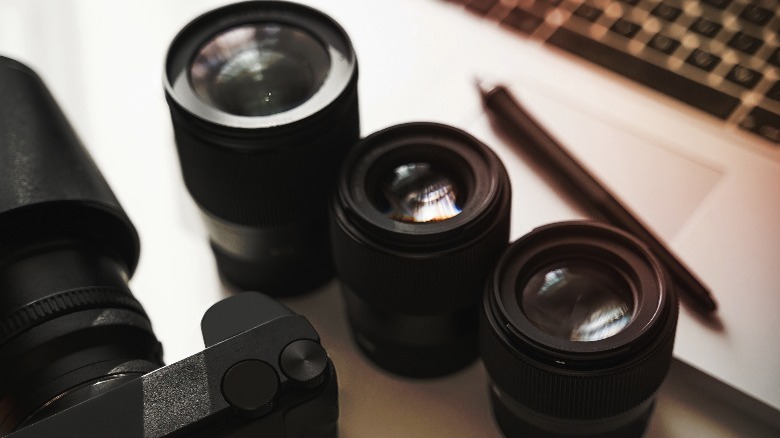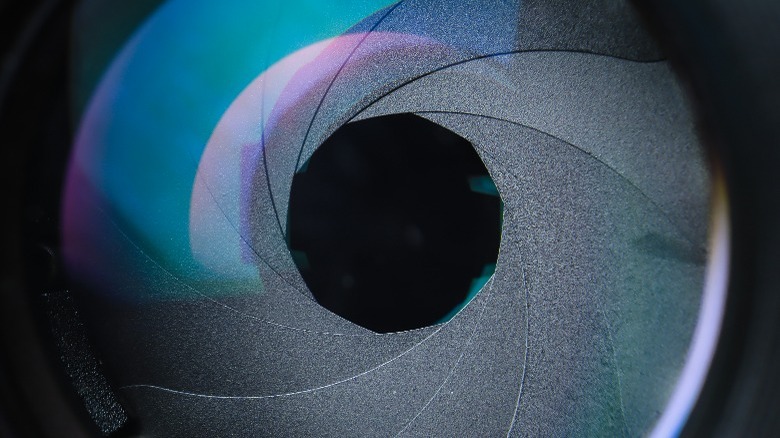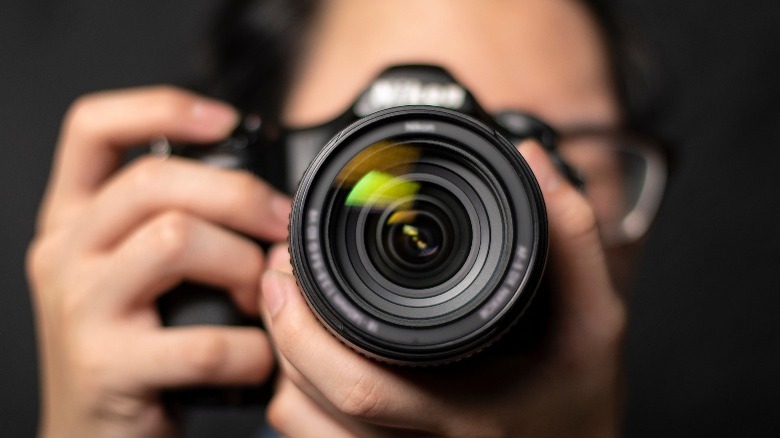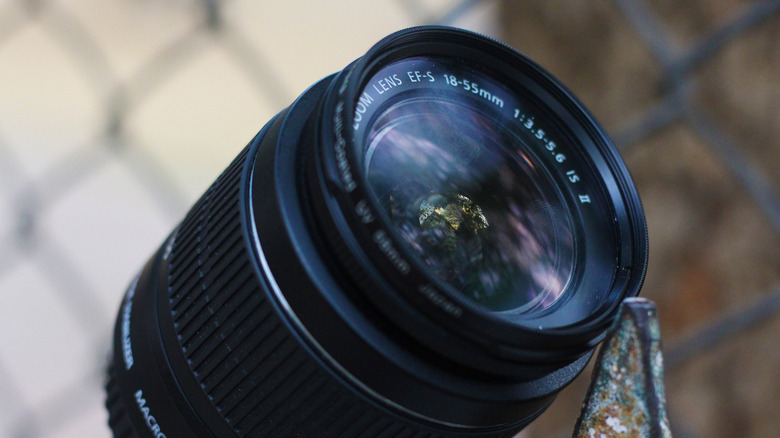5 Things You Need To Look For When Buying A Camera Lens
Digital cameras have unlocked a landscape for capturing memories, and although smartphones have been getting increasingly good at taking photos and videos, there is still a healthy market for DSLR (digital single-lens reflex) enthusiasts. Popular offerings from Canon, Sony, and Nikon are available at every price tier, making professional photography and videography accessible to everyone.
Unfortunately, most people purchase their very first digital camera and are content with the supplied accessories — among which the lens is the most important. To bring the retail prices down, camera manufacturers ship versatile, yet basic lenses, usually referred to as the "kit" lens. While there is absolutely nothing wrong with using a kit lens, your camera's body is capable of outputting much more.
Options are seemingly endless when you start looking for extra essential lenses for your camera. Some are small in size, while others resemble a literal telescope — and it isn't uncommon to find official listings of lenses that are more expensive than the camera itself. In this sea of optics, there are certain things to be sure of before buying new eyes for your camera, and we're here with five of the most important considerations you should make.
Form Factor
Perhaps the most crucial decision to make before purchasing expensive glass is to check if it's going to fit your camera in the first place. Digital cameras not only have different crop formats that you'd want your lens to match but also have specific mounting systems. Canon widely uses the EF-S mount, while Nikon cameras often utilize the F-mount. This is the first confirmation you'd need to make as a mismatch between the mounting types will render your lens useless.
You'll also notice the terms "full-frame" and "APS-C" being thrown around a lot when scouting for camera hardware. Put simply, these are formats that indicate the size of your camera's sensor. A full-frame sensor is able to capture a wider field of view, while an APS-C sensor offers a zoomed-in crop, ideal for portraits of people and pets. Most beginner-friendly digital cameras sport an APS-C-sized sensor, the lenses for which are often cheaper, smaller, and lighter in weight in comparison to full-frame lenses.
As a general rule of thumb, you can use all full-frame compatible lenses on an APS-C camera too, but the reverse is not possible. So if you plan on upgrading to a more powerful camera in the future, investing in a full-frame lens has its benefits.
Focal Length
Once you have compatibility sorted out, the next most important factor to consider before buying a new camera lens is its focal length. Depending on your requirements, you might enjoy a lens that offers a wider field of view, or one that zooms in for a narrower, yet detailed image. Focal length is represented using numbers, and depending on your lens type, you might see one or two of these measurements.
For example, most kit lenses bundled with your camera have a variable focal length of 18-55mm — where 18mm represents the lens at its widest, and 55mm depicts the maximum it can zoom into. This is different from the digital zoom you do on your smartphones since different focal lengths significantly alter the way your image appears on a digital camera. Ultra wide-angle lenses with focal lengths of 16mm and below produce images with a fish-eye effect.
Prime lenses work on a fixed focal length, which is why you'll only see a single measurement. Where they lack in flexibility, they make up in price, aperture, and compactness. It's good to note that the advertised focal lengths on lenses are concerning a full-frame sensor. So, a 24mm lens on an APS-C sensor is not going to be as wide as it would be on a full-frame camera.
Aperture
Try squinting your eyes and observing your surroundings and various objects up close — you'll notice not only less light but a distinct lack of depth. This is exactly how the aperture of a camera's lens affects the images it produces. A wider aperture means more light going into the sensor, resulting in a brighter image that has more background blur. The aperture of a lens is usually denoted by a capital or slanted "F", followed by a number.
The smaller the value, the higher the aperture. Most kit lenses offer a range of f/3.5 to f/5.6, where the aperture dynamically shifts between the widest and zoomed-in focal lengths. Prime lenses usually offer better apertures like f/1.4 or f/1.8, which provide the silky blurry backgrounds that you see in portraits of people or products. These numbers represent the maximum aperture value of a lens, and you can digitally dial this metric up to reduce background blur in favor of a more consistent image.
Aperture is one of the most basic DSLR camera settings you should get familiar with. If you plan on shooting in low light a ton, a wider aperture is going to be crucial. For landscape or wildlife photography, you might benefit from zoom lenses that often have narrower apertures.
Autofocus or Manual?
We've come a long way surviving the slow and inaccurate autofocus mode on our smartphones, with the feature now being used as a staple. The story is a bit different when it comes to digital cameras. While most camera lenses offer an autofocus mechanism, the experience varies drastically from lens to lens. With the perfect combination of a DSLR or mirrorless camera that has the latest autofocusing tech and a first-party lens, results can be instantaneous.
On the other hand, most professional photographers and videographers prefer to use manual focus. Though every lens capable of autofocus has a switch that lets you switch to manual mode, certain designs and grippy focus rings offer smooth transitions. Although most cameras and lenses use electronic focusing systems, the autofocus performance may vary if you opt for third-party lenses, so if you're into action photography, you might want to reconsider your options.
Other considerations to make
Apart from the aforementioned major factors, there are other features that can sway your purchase decision — pricing being an important one. You can often find lenses from third-party manufacturers that offer the same focal lengths and hardware for attractive discounts. Popular and reputed camera lens manufacturers include Sigma, Tamron, and Olympus.
Most DSLRs and mirrorless cameras come with in-body stabilization, which is good enough for when you're using lenses of wide and normal focal lengths to shoot regular subjects. However, the greater you zoom in, the more visible are the tiniest acts of camera shake — which is why most telephoto lenses come with in-lens stabilization as well. Both of these systems work in conjunction to minimize shaky images or videos.
Build quality might be a topic of interest to those who plan on using their equipment in challenging environments. Camera lenses are essentially delicate glass, and all that cushions the expensive bits of your lens from the rough terrain is the outer covering. You can find lenses with weatherproofing that make them ideal for use in rain, snow, or harsh sunlight.

